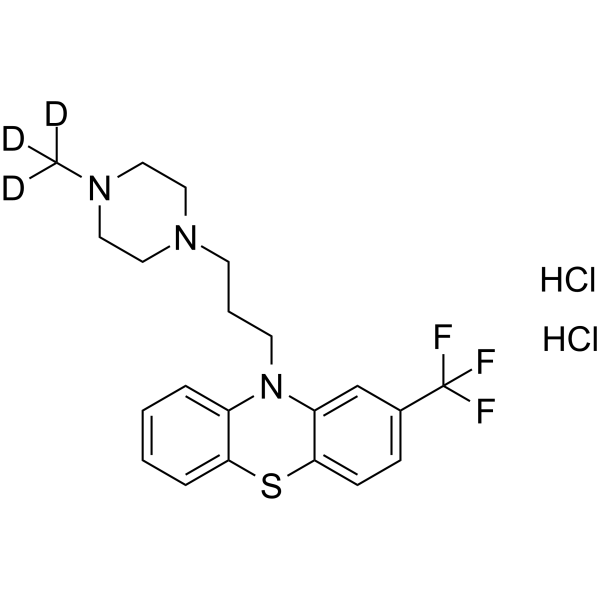Trifluoperazine-d3 (hydrochloride)
Modify Date: 2025-09-16 23:11:47

Trifluoperazine-d3 (hydrochloride) structure
|
Common Name | Trifluoperazine-d3 (hydrochloride) | ||
|---|---|---|---|---|
| CAS Number | 1432064-02-2 | Molecular Weight | 483.44 | |
| Density | N/A | Boiling Point | N/A | |
| Molecular Formula | C21H23D3Cl2F3N3S | Melting Point | N/A | |
| MSDS | N/A | Flash Point | N/A | |
Use of Trifluoperazine-d3 (hydrochloride)Trifluoperazine-d3 (dihydrochloride) is deuterium labeled Trifluoperazine (dihydrochloride). Trifluoperazine dihydrochloride, an antipsychotic agent, acts by blocking central dopamine receptors. Trifluoperazine dihydrochloride is a potent α1-adrenergic receptor antagonist. Trifluoperazine dihydrochloride is a potent NUPR1 inhibitor exerting anticancer activity. Trifluoperazine dihydrochloride is a calmodulin inhibitor, and also inhibits P-glycoprotein. Trifluoperazine dihydrochloride can be used for the research of schizophrenia. Trifluoperazine dihydrochloride acts as a reversible inhibitor of influenza virus morphogenesis[1][2][3][4][5]. |
| Name | Trifluoperazine-d3 (hydrochloride) |
|---|---|
| Synonym | More Synonyms |
| Description | Trifluoperazine-d3 (dihydrochloride) is deuterium labeled Trifluoperazine (dihydrochloride). Trifluoperazine dihydrochloride, an antipsychotic agent, acts by blocking central dopamine receptors. Trifluoperazine dihydrochloride is a potent α1-adrenergic receptor antagonist. Trifluoperazine dihydrochloride is a potent NUPR1 inhibitor exerting anticancer activity. Trifluoperazine dihydrochloride is a calmodulin inhibitor, and also inhibits P-glycoprotein. Trifluoperazine dihydrochloride can be used for the research of schizophrenia. Trifluoperazine dihydrochloride acts as a reversible inhibitor of influenza virus morphogenesis[1][2][3][4][5]. |
|---|---|
| Related Catalog | |
| In Vitro | Stable heavy isotopes of hydrogen, carbon, and other elements have been incorporated into drug molecules, largely as tracers for quantitation during the drug development process. Deuteration has gained attention because of its potential to affect the pharmacokinetic and metabolic profiles of drugs[1]. |
| References |
| Molecular Formula | C21H23D3Cl2F3N3S |
|---|---|
| Molecular Weight | 483.44 |
| Exact Mass | 482.136475 |
| 10-{3-[4-(2H3)Methyl-1-piperazinyl]propyl}-2-(trifluoromethyl)-10H-phenothiazine dihydrochloride |
| 10H-Phenothiazine, 10-[3-[4-(methyl-d3)-1-piperazinyl]propyl]-2-(trifluoromethyl)-, hydrochloride (1:2) |
| Trifluoperazine-d3 (hydrochloride) |